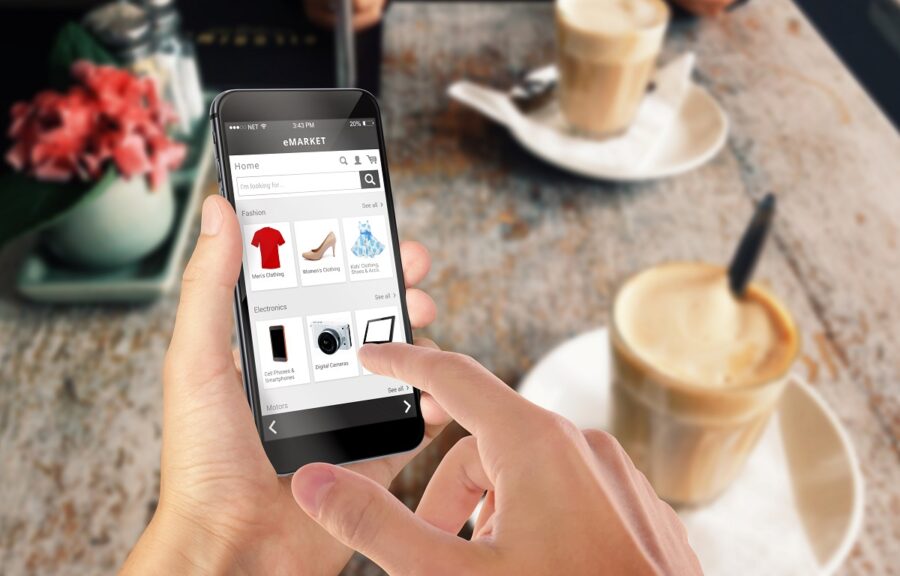
Our Blog
Digital Transformation in Retail: The Need is Now
Written by: Parcel Pending
6 Min Read
Published: October 26, 2023
The pandemic permanently changed the retail industry. Savvy retailers welcomed retail digital transformation to survive. Now, the stakes are higher for every retail business, with the need for retailers to expedite digital adoption and harness the power of digital technology to deliver sales and continued growth in the retail sector.
| Retail digital transformation is when retailers leverage technology, e-commerce, omnichannel marketing and Artificial Intelligence (AI) to drive operational efficiencies while offering a customer-centric approach to retail. |
Seismic Changes in the Retail Industry
Retailers used to compete based on the number of stores and proximity to customers. With as many as 36 million Americans working remotely today, commutes have changed dramatically, translating into fewer store visits and location playing a smaller role in customer acquisition and retention.1 Further, retail establishments paralleled the movement of consumers from big cities to smaller, more affordable cities such as those in the Sun Belt.
With a mobile phone in the hands of virtually every shopper, competing merely on price also became outdated. In fact, 74% of retail site traffic in Q1 2023 and 63% of online orders are generated by smartphones.2
The demand for a consistent experience across all channels drove early digital adoption initiatives for omnichannel marketing. Today, the key opportunity in the retail industry is to marry in-store with digital technology and online purchases to capture customer data and create personalized offers.
The Benefits of Digital Transformation
Digital transformation, powered by automation, the Internet of Things (IoT), Artificial Intelligence (AI), and machine learning, offers enormous benefits to retailers including:
Boosting the Customer Experience & Customer Retention
When a customer can seamlessly switch between a retailer’s app, chatbot, and wish list, customer retention soars. Target’s app, for instance, incorporates a store directory to help shoppers quickly locate items, allows the download of instant coupons, offers easy scanning of their wallet’s barcode at checkout, keeps a shopping list as well as a list of favorites, and even connects them with their local store for faster curbside pick-up!
Improving Operational Efficiency
Leveraging digital transformation in retail allows for optimizing inventory management, forecasting, and supply chain processes. These changes, in turn, deliver lower costs and more in-stock availability. Case in point, Walmart started using its retail stores as a fulfillment center coupled with warehouse automation which led its U.S. business to reduce stock-outs in the latest quarter while reporting 8% less inventory.3
Driving Growth
The relationship between experience and sales is clear to many in the retail sector. For example, in May of 2023, Target reported a staggering 12th consecutive quarter of year-over-year growth, outperforming Costco and even Walmart.4 Digitally mature companies are 26% more profitable than their less techno-savvy competitors.5
Differentiating their Competitive Advantages
Marketers used to claim that if you walked into a brick-and-mortar store and couldn’t identify the brand name of the retailer within a few seconds, the brand has morphed into “the sea of similarity”. Today, however, retailers broadcast their points of difference through displays, recommended products, social media posts, and email communication that is consistent with their brand DNA.
The Future of Digital Transformation
Personalization, data-informed decision-making, tech investments, and virtual shopping experiences are essential trends that a retail business must address to stay relevant in a fast-paced industry.
Personalized Customer Journeys
According to recent research, 63% of respondents state that they are more likely to shop with brands that customize and personalize the experience for the shopper.6 As Alex Atzberger, CEO of Optimizely explains: “Retailers have a captive audience of consumers who are seeking relevant content, ideas and offers online. However, only the brands that have progressed their digital maturity through experimentation and personalization to become adaptive to consumer needs will differentiate and win over shoppers.”
Further, According to Adobe Analytics, 79% of retailers currently invest in personalization and, along with omnichannel retail (using three or more channels to communicate with a potential customer) can increase customer orders by nearly five times and spend by 10%.7
Data-Informed Decision-Making
Big data and data analytics come together to assist retailers in more informed decision-making. Sales forecasting, customer communication, in-store and online merchandising, and price optimization are direct results of these efforts. As McKinsey & Company explains in a recent retail report: “Digital native Delivery Hero, for instance, harnesses customer data to calculate customer lifetime value and thereby inform strategic and tactical decisions depending on the value of specific customer segments. It uses these insights to shape decisions such as whether to run a marketing campaign for a specific segment or whether or not it should enter a new market.”8
Savvy Tech Investments
Legacy systems are old software models that don’t operate in the cloud or lack an API to easily integrate with other programs. Investment, confusion, and lack of good cost/benefit decision-making often hold retailers back from pulling the trigger. Not investing in digital transformation today prevents store owners from growing sales, improving the in-store customer experience and customer service experience, easily accepting returns, accurately forecasting inventory, offering new promotions, or implementing sophisticated omnichannel marketing efforts.
Offering BOPIS (Buy Online, Pick-Up In-Store) and BOPIL (Buy Online, Pick-Up in Locker) is vital to remaining competitive and growing sales.
Virtual Reality & Augmented Reality
Both Virtual Reality (VR) and Augmented Reality (AR) allow customers to see how a product will look on their body or in their homes. This application is perfect for make-up retailers like Sephora and Ulta, which both offer virtual make-up try-on. Warby Parker also uses a virtual application to see how a pair of glasses will look on shoppers. A Deloitte Digital study found nearly 75% of the global population and almost all smartphone users will be frequent AR users by 2025.9
Start-up Alvanon, for instance, is developing a consumer app, called MyAlva, that allows shoppers to virtually try on clothes to see how they fit and look.10 Consumers upload photos or measurements, and the app determines a recommended size. Of course, the ultimate goal is to reduce the number of returns and prevent the practice of “bracketing” – buying the same item in multiple sizes to determine which one fits best.
Digital Transformation + Smart Lockers = Top Technology Investment
It’s clear that every element of technology is intertwined with the customer experience. Determining the priority of investment in digital transformation should be viewed through the lens of Return on Investment (ROI), lifetime value of the customer, customer loyalty, sales increases, market share, data analytics, and the customer experience.
As a result, installing smart lockers (also know as electronic lockers, retail lockers, or parcel lockers) leapfrogs to the top of the top of the technology pyramid. The statistics are jaw-dropping:
- 61% of omnichannel shoppers make an unplanned, additional purchase when retrieving their online orders.
- 95% of BOPIS customers are more likely to become returning customers.11
- Retailers that employ BOPIL can reduce manual order management process by up to 50% using BOPIL.12
- 59% of consumers expect to find it available on their customer shopping journey.13
Digital transformation in retail is the secret to remaining competitive. Kicking to the curb legacy systems and embracing modern technology allows for exponential jumps in sales and profits.
Ready to take the first step in transforming your store experience? Speak to one of our smart locker experts today!
Sources:
- Flynn, Jack. 25 Trending Remote Work Statistics [2023]: Facts, Trends, and Projections. www.zippia.com. June 13, 2023. https://www.zippia.com/advice/remote-work-statistics/
- Chevalier, Stephanie. Distribution of retail website visits and orders worldwide in 1st quarter 2023, by device. www.statista.com. July 18, 2023. https://www.statista.com/statistics/568684/e-commerce-website-visit-and-orders-by-device/
- Young, Liz. Target Goes Local to Speed Up Order Deliveries. www.wsj.com. August 24, 2023. https://www.wsj.com/articles/target-goes-local-to-speed-up-order-deliveries-bb7b9251?
- Lee, Jinjoo. Target Tries to Sell ‘Affordable Joy’ as Consumers Pull Back. www.wsj.com. May 17, 2023. https://www.wsj.com/articles/target-tries-to-sell-affordable-joy-as-consumers-pull-back-fc77f142
- Impact Networking. How to Get a Competitive Advantage with Digital Transformation. www.impactmybiz.com. June 10, 2019. https://www.impactmybiz.com/blog/blog-how-to-get-a-competitive-advantage-with-digital-transformation/
- Optimizely. Optimizely Survey: Consumers Report Heightened Expectations for Digital Experiences this Holiday Season. www.optimizely.com. October 14, 2021. https://www.optimizely.com/company/press/heightened-expectations-for-digital-experiences-this-holiday-season/
- Adobe Communications Team. A guide to retail customer experience trends in 2023. business.adobe.com. November 17, 2022. https://business.adobe.com/blog/the-latest/retail-customer-experience-trends-2023.
- Bick, R., Bout, S., et al. The tech transformation imperative in retail. www.mckinsey.com. May 20, 2022. https://www.mckinsey.com/industries/retail/our-insights/the-tech-transformation-imperative-in-retail
- Forman, Laura. Augmented Reality is What’s in Store for Commerce. www.wsj.com. April 20, 2022. https://www.wsj.com/articles/augmented-reality-is-whats-in-store-for-commerce-11650466244
- O’Brien, Sara Ashley. These Companies Have a Revolutionary Idea: Clothes That Actually Fit. www.wsj.com. September 9, 2023. https://www.wsj.com/style/fashion/clothing-size-perfect-fit-tech-59ff9984
- Based on client data; your results may vary.
- Ibid.
- Salesforce. Global Online Sales Top $1.14T During 2022 Holiday Season, Salesforce Data Reveals. www.prnewswire.com. January 9, 2023. https://www.prnewswire.com/news-releases/global-online-sales-top-1-14t-during-2022-holiday-season-salesforce-data-reveals-301716988.html



